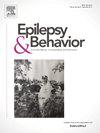Global patterns and predictors of anti-seizure medication adherence in pediatric epilepsy: A systematic review and meta-analysis
IF 2.3
3区 医学
Q2 BEHAVIORAL SCIENCES
引用次数: 0
Abstract
Background
Epilepsy is a chronic neurologic disorder that affects around 50 million individuals worldwide, disproportionately affecting children and young adults. Anti-seizure medication is vital to control seizures, yet adherence remains a key public health concern. While there are scattered individual studies addressing these issues, there is no summary of evidence. This systematic review and meta-analysis will give an estimate of global adherence prevalence, regional variations and determinants, and offer suggestions on improving medication adherence in this vulnerable population.
Methods
Following the Preferred Reporting Items for Systematic Reviews and Meta-Analyses guidelines, we searched PubMed, Embase, Scopus, Web of Science, and the Cochrane Database of Systematic Reviews for studies reporting on the adherence of anti-seizure medication among children and adolescents. We employed random-effects model to calculate pooled estimates. Additionally, heterogeneity, publication bias and sensitivity analysis was performed.
Results
The final analysis consisted of 41 studies on a sample of 13,747. The pooled prevalence of adherence to anti-seizure medication in children and adolescents with epilepsy was estimated to be 63.96% (95% CI: 59.36%–68.57%). Independent predictors of medication adherence in the study were: children and adolescents of mothers with highest educational levels (AOR: 2.07, 95% CI: 1.01–3.14), recently diagnosed children and adolescents with epilepsy (AOR: 2.20, 95% CI: 1.25–3.16), parents with annual healthcare costs of over $7,000 (AOR: 0.53, 95% CI: 0.30–0.76), and patients on monotherapy (AOR: 3.03, 95% CI: 2.47–3.60).
Conclusion
This meta-analysis found that there was a suboptimal rate of adherence to anti-seizure medication in children and adolescents. Predictors were maternal education, time since diagnosis, cost, and polypharmacy. The findings confirm the necessity of intervention into socioeconomic status and treatment complexity to improve adherence.
儿童癫痫抗癫痫药物依从性的全球模式和预测因素:一项系统回顾和荟萃分析
癫痫是一种慢性神经系统疾病,全世界约有5000万人受其影响,儿童和年轻人受影响尤为严重。抗癫痫药物对控制癫痫发作至关重要,但依从性仍然是一个关键的公共卫生问题。虽然针对这些问题有零散的个别研究,但没有证据的总结。本系统综述和荟萃分析将给出全球依从性流行率、区域差异和决定因素的估计,并为改善这一弱势群体的药物依从性提供建议。方法根据系统评价和荟萃分析指南的首选报告项目,我们检索了PubMed, Embase, Scopus, Web of Science和Cochrane系统评价数据库,以报告儿童和青少年抗癫痫药物依从性的研究。我们采用随机效应模型计算汇总估计。此外,还进行了异质性、发表偏倚和敏感性分析。结果最终的分析包括41项研究,涉及13747个样本。儿童和青少年癫痫患者抗癫痫药物的总依从率估计为63.96% (95% CI: 59.36%-68.57%)。研究中药物依从性的独立预测因子为:母亲受教育程度最高的儿童和青少年(AOR: 2.07, 95% CI: 1.01-3.14),最近诊断为癫痫的儿童和青少年(AOR: 2.20, 95% CI: 1.25-3.16),每年医疗费用超过7,000美元的父母(AOR: 0.53, 95% CI: 0.30-0.76),以及接受单一疗法的患者(AOR: 3.03, 95% CI: 2.47-3.60)。结论:本荟萃分析发现,儿童和青少年抗癫痫药物的依从性不理想。预测因子为母亲教育程度、诊断后时间、费用和多药。研究结果证实了干预社会经济地位和治疗复杂性的必要性,以提高依从性。
本文章由计算机程序翻译,如有差异,请以英文原文为准。
求助全文
约1分钟内获得全文
求助全文
来源期刊

Epilepsy & Behavior
医学-行为科学
CiteScore
5.40
自引率
15.40%
发文量
385
审稿时长
43 days
期刊介绍:
Epilepsy & Behavior is the fastest-growing international journal uniquely devoted to the rapid dissemination of the most current information available on the behavioral aspects of seizures and epilepsy.
Epilepsy & Behavior presents original peer-reviewed articles based on laboratory and clinical research. Topics are drawn from a variety of fields, including clinical neurology, neurosurgery, neuropsychiatry, neuropsychology, neurophysiology, neuropharmacology, and neuroimaging.
From September 2012 Epilepsy & Behavior stopped accepting Case Reports for publication in the journal. From this date authors who submit to Epilepsy & Behavior will be offered a transfer or asked to resubmit their Case Reports to its new sister journal, Epilepsy & Behavior Case Reports.
 求助内容:
求助内容: 应助结果提醒方式:
应助结果提醒方式:


